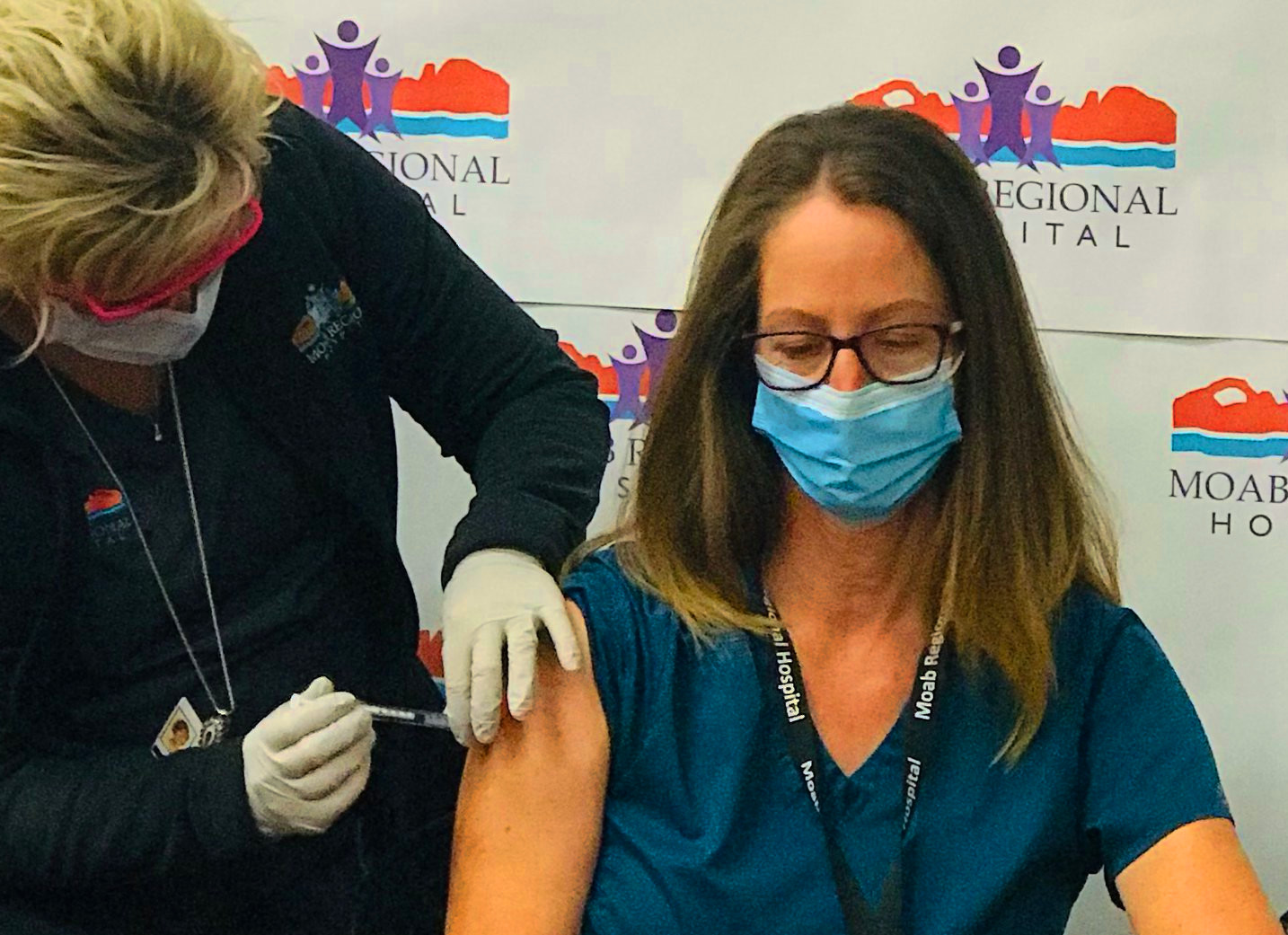Utah hospitals and frontline workers are receiving COVID-19 vaccines in southeastern Utah, after the U.S. Food & Drug Administration granted emergency authorizations to Pfizer and Moderna for vaccines to fight the coronavirus.
Frontline employees at Moab Regional Hospital received the first round of vaccines on Dec. 28. Some of the first people vaccinated in Moab were staff of the MRH Respiratory Evaluation Area, a new department at the hospital created to respond to the coronavirus pandemic.
“We are so happy to have been blessed with the vaccine and the support of our administration. We really feel like it’s kind of the beginning of the end of this COVID crisis,” said Darci Miller, the director of quality assurance and a member of the hospital’s vaccine committee. “We can take a deep breath and hopefully see everyone’s beautiful smile soon.”
That feeling of relief was shared by Nicole Fox, a Moab resident and physician assistant at San Juan Hospital in Monticello. On December 23, Fox and nine of her coworkers received the Moderna vaccine.
“I feel like I can walk around a little bit more safely. The big thing was to hopefully not be a carrier to other people, because that’s been my major concern,” said Fox. She said that she knew multiple frontline healthcare workers who have contracted COVID-19.
“It’s just such an infectious virus, it’s really hard to not get people exposed if they’re in the healthcare workforce,” Fox said.
The Centers for Disease Control and Prevention and the Utah Department of Health recommend that the vaccine be distributed in four waves, according to Moab Regional Hospital officials. First responders and frontline workers get vaccinated first, followed by long-term care facility residents. After those highest-risk populations get vaccinated, emergency responders and other healthcare workers will be next in line, then people at risk of serious illness and people above the age of 65. After that, the general public will be able to get vaccinated. That fourth wave should come by the summer of 2021, officials from the Utah Department of Health say.
Locally, the Southeast Utah Health Department is overseeing the vaccine rollout and posting information on their website at www.seuhealth.com
Both San Juan Hospital and Moab Regional Hospital are staggering their vaccination schedule to prevent any side-effects from causing a staff shortage. However, no side effects beyond a sore arm at the site of the injection have been reported at either hospital.
According to published scientific studies, both the Moderna and Pfizer vaccines appear highly effective at preventing the disease caused by the novel coronavirus, with 94% and 95% rates of efficacy respectively. Both vaccines are reported to cause minor side effects like headaches and fatigue.
The vaccines are being recognized as historic, developed in record-breaking time. Previously, the fastest vaccine produced was for mumps, which took four years to produce.
The federal government’s Operation Warp Speed allowed drug makers to begin producing vaccines en masse, even as they worked through the rounds of studies to ensure both efficacy and safety of their products. This is partly why multiple companies were able to produce safe and effective vaccines in a lighting-fast nine months.
Unlike previous vaccines, the Pfizer and Moderna products do not use the live virus, nor can they give someone a COVID-19 infection. Instead, they use more simple genetic material to allow the patient’s antibodies to recognize and effectively defend against the novel coronavirus.
Dr. Eric J. Hanly, a surgeon at Moab Regional Hospital, wrote an editorial reporting that while he had previously felt skeptical about a vaccine developed so quickly, he had examined the scientific research published in the New England Journal of Medicine.
“For me, reading this publication early one morning last week was a rare emotional high after another stressful week at the hospital ‘dealing with COVID,’” Hanly wrote. “For the first time in nine months, I felt a glimmer of hope that maybe, just maybe, we will be able to get back to life as we knew it.”
He received his first dose of the vaccine at St. Mary’s Medical Center in Grand Junction in December.
Fox agreed that seeing the impact of the COVID-19 pandemic has made her more passionate about the vaccine.
“I know lots of families where people have passed away due to COVID,” she said, “so I see the harms of COVID as being very real, and very present in the community where I work.”
Fox went on to say that she has seen a wide array of lasting symptoms from COVID-19, even after patients were over the acute infections. In particular, Fox said many of her older patients especially had difficulties returning to their pre-COVID health baseline.
While the vaccine development is key to ending the ongoing COVID-19 pandemic, which has claimed the lives of over 336,000 Americans, experts urge caution and continued attention to the basics: social distancing, handwashing and staying home if you are feeling ill.
“I, as a person, not just a healthcare provider, I feel very comfortable with the vaccine. I really encourage people if they are able to get it, to get it,” said Fox.
Those who show any symptoms of COVID-19 are encouraged to get tested at Moab Regional Hospital. To talk to a nurse about symptoms and schedule a test, call the Moab Regional Hospital COVID-19 hotline at 435-719-3998.
For information and questions about the COVID-19 vaccination distribution plan in southeastern Utah, go to www.seuhealth.com




